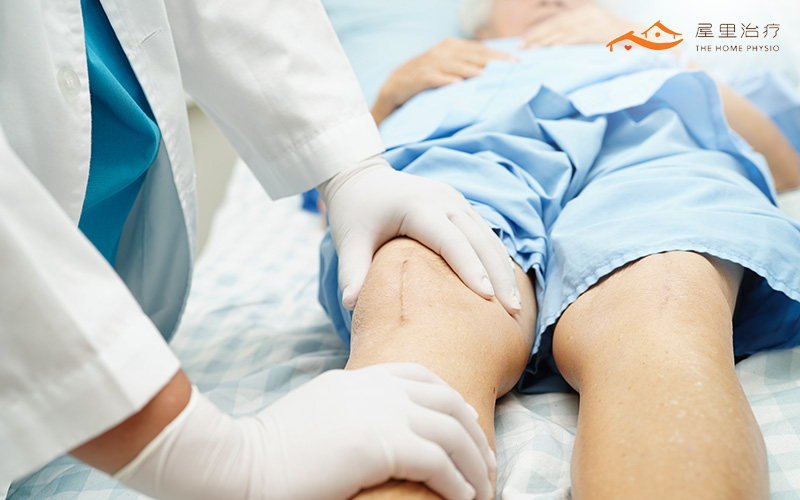Whether you have undergone a total knee replacement (TKR), arthroscopy, or ligament repair, knowing what to expect during your recovery can help reduce anxiety and promote smoother healing. While every person heals differently, there are predictable milestones that influence the recovery time after a knee operation.
In this article, we break down a typical knee surgery recovery timeline to help you understand each phase of rehabilitation—along with practical strategies for navigating each stage safely.
Key Takeaways
- Knee operation recovery time varies depending on the type of surgery, but most people regain basic mobility within 6–12 weeks, with full recovery potentially taking several months.
- A typical recovery timeline includes distinct stages: initial pain management, regaining movement, building strength, and returning to full function.
- Guided post-operation rehabilitation can support steady progress while reducing the risk of complications.
- Avoiding common mistakes—like overexertion, inconsistent exercise, or poor home setups—can make a meaningful difference in outcomes.
- Loved ones play an important role in helping with daily needs and creating a safe space for post-surgical rehab at home.
What Are the Recovery Stages After Knee Surgery?
The recovery time after a knee operation can vary based on the type of procedure and individual factors such as age, overall health, and physical activity levels. While many patients are able to resume most daily activities within 3 to 6 months, full recovery—including strength, mobility, and joint function—may take up to a year.
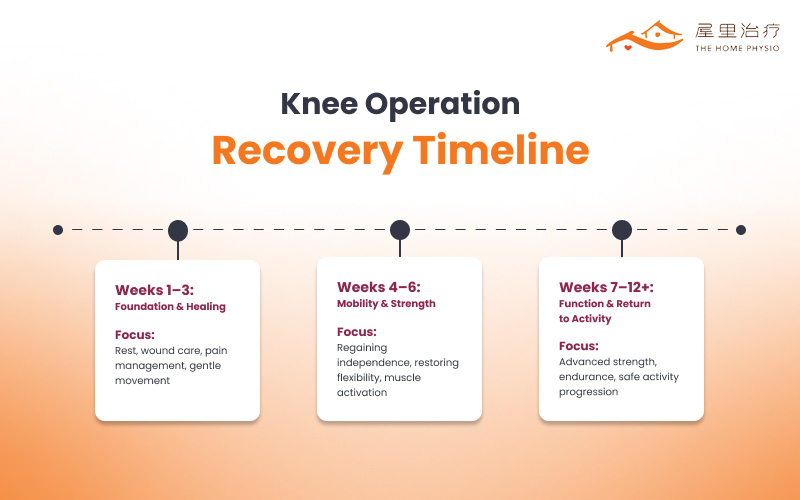
Weeks 1 to 3: Rest, Pain Management, and Basic Mobility
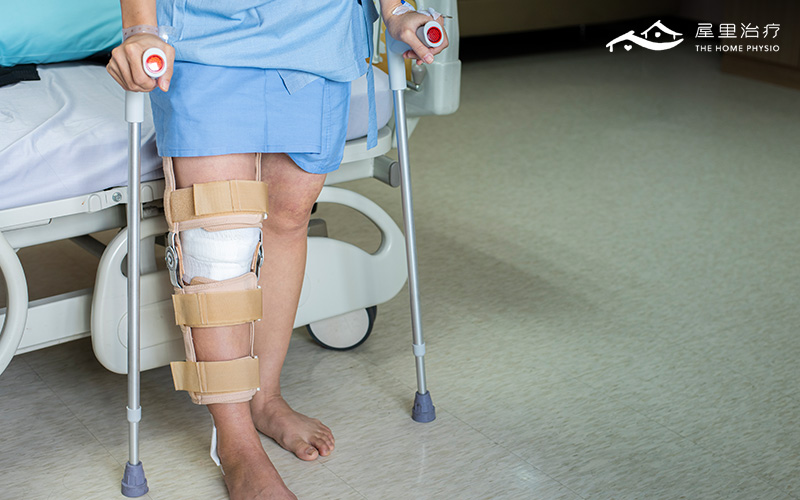
This early stage of the knee replacement healing process is often the most delicate. Your body is focused on recovery, and laying the groundwork for steady progress is key.
Pain and Swelling Management
It is common to feel pain, swelling, and bruising around the joint in the initial weeks after knee surgery. To manage inflammation, your doctor may recommend using cold therapy, elevating the leg, and applying compression. You may also be prescribed over-the-counter or stronger pain medication to ease discomfort and support early mobility.
Wound Care and Monitoring
Keeping the surgical wound clean and dry helps reduce the risk of infection. Change dressings as instructed by your doctor—typically every few days—and monitor for warning signs like persistent bleeding, unusual odour, pus, or fever. Report any concerns to your care team promptly to avoid delays in your knee operation recovery time.
Early Mobilisation
Your doctor will encourage you to begin with gentle activities, like ankle pumps and toe curls, to enhance blood circulation and prevent blood clots. You may begin by sitting up, standing briefly with assistance, or walking short distances using a mobility aid. These small movements promote circulation and flexibility—crucial for maintaining momentum throughout the healing process.
Physiotherapy Begins
Even in this early phase, post-operative physiotherapy is crucial. Your physiotherapist will focus on gentle range-of-motion exercises, light strength-building activities, and introductory gait training to prevent joint stiffness and promote circulation. The goal is to ease your body into movement without overexerting it, which can prolong your knee operation recovery time.
Use of Assistive Devices
Use walking aids like crutches, walkers, or frames to move safely around your home. These devices make it easier to get in and out of bed, use the bathroom, and move between rooms while keeping weight off the healing joint. Using them correctly helps prevent strain and lowers the risk of falls, which can negatively impact your knee operation recovery time. This is particularly crucial for older adults or those recovering from more complex procedures like bilateral knee replacements.
Weeks 4 to 6: Regaining Mobility and Building Strength
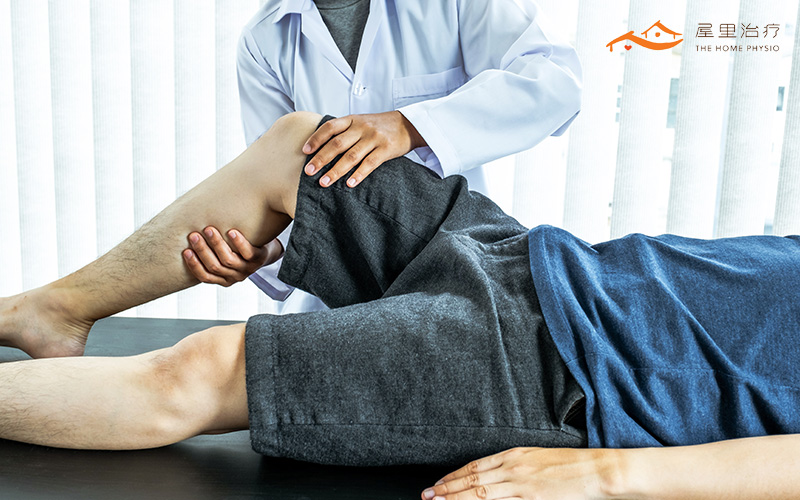
As the wound heals and pain stabilises, the focus shifts toward supporting mobility, muscle engagement, and functional movement.
Enhancing Patient Independence
By now, many patients will begin to manage daily tasks with less assistance. You may start dressing yourself, preparing simple meals, or using the toilet more independently. Some may even return to desk-bound work or resume driving short distances, provided they have obtained approval from their doctor.
Expanding Range of Motion
Regaining the ability to bend and straighten your knee is a key focus at this period. Your physiotherapist will guide you through exercises such as heel slides, knee bends, and wall-assisted extensions to help restore flexibility. The goal is typically to achieve 90 to 120 degrees of motion by the end of week 6.
Muscle Activation and Strengthening
Your leg muscles—especially the quadriceps, hamstrings, and glutes—likely weakened during the early healing phase. To rebuild them, your physiotherapist may introduce:
- Straight leg raises
- Seated marches
- Mini squats with support
- Resistance band exercises
These movements can help support the joint, enhance balance, and prepare your body for more demanding tasks further down the line.
Monitoring Progress and Setbacks
It is normal to feel occasional soreness or tightness after physiotherapy, but persistent swelling or sharp pain could indicate overuse. Consistent, tailored support from your physiotherapist can help reduce the risk of complications and keep your post-knee operation rehabilitation on track.
Weeks 7 to 12 and Beyond: Return to Function and Long-Term Recovery
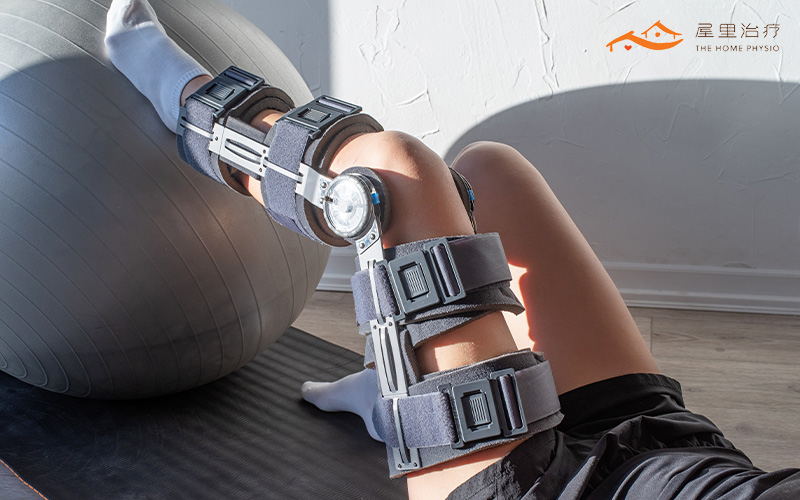
By this stage, you are likely to be moving more independently. That said, structured effort and consistency remain essential to keeping your knee operation recovery time minimal, particularly if you lead an active lifestyle or have higher mobility goals.
Advanced Strength and Endurance Training
Your physiotherapy programme will now include more dynamic movements to rebuild strength and coordination. These may involve step-ups, lunges, and low-impact cardiovascular exercises such as stationary biking or swimming. Your physiotherapist will also adjust the intensity based on your needs and healing pace.
Lingering Discomfort and Joint Awareness
It is common to experience mild aches or stiffness for several months, particularly after physical activity. While this is a normal part of the healing process, it is important to distinguish routine post-operative soreness from unwanted complications.
Avoid High-Impact Activities
During this phase, avoid running, jumping, or sports that place sudden strain on the knee unless specifically approved by your surgeon or physiotherapist. These activities can increase the risk of injury and further extend your knee operation recovery time.
If you plan to return to a sport or a physically demanding job, your physiotherapist may create a customised reconditioning programme as part of your long-term post-surgical rehab.
How to Make the Most of Your Knee Operation Recovery Time at Home
Even with clear post-surgical instructions, it is easy to develop habits that unintentionally prolong your knee operation recovery time or increase the risk of complications. Recognising these common mistakes and taking proactive steps can help you stay on track and contribute to a more stable and consistent recovery.
Common Mistakes That Can Delay Your Knee Operation Recovery Time
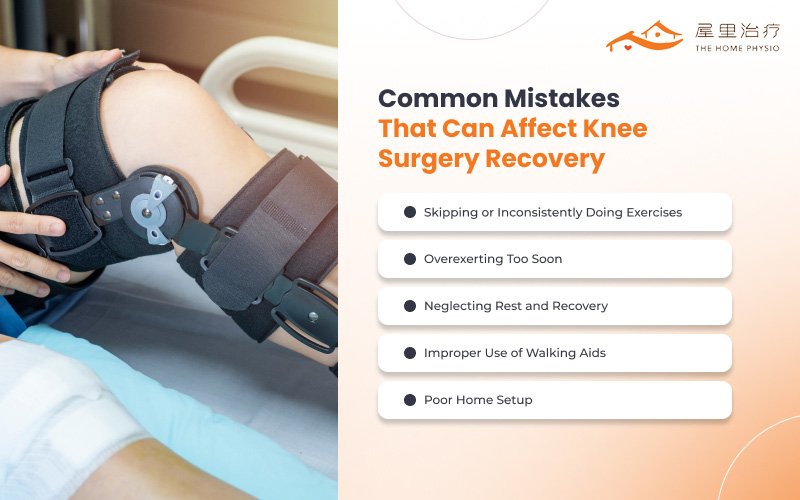
Skipping or Inconsistently Doing Exercises
It is common for patients to skip their prescribed exercises or perform them inconsistently—especially without direct supervision. Over time, they may forget their routines, apply improper techniques, and lose motivation.
This is where home physiotherapy in Singapore comes in, providing regular, in-person guidance to ensure exercises are performed correctly and consistently. They can adjust your rehabilitation plan based on progress, address any difficulties early on, and keep you motivated throughout.
Overexerting Too Soon
As symptoms improve, some patients may become overconfident and push too hard, too soon. They may try to “test” their progress by walking long distances, climbing stairs frequently, or lifting heavy objects before their body is ready. This can lead to swelling, increased pain, or even setbacks like tendon strain—which may slow down your knee operation recovery time.
A physiotherapist will help pace your recovery carefully, such as by introducing new activities only when your body is ready and monitoring how you respond. This approach helps you build strength safely while avoiding unnecessary setbacks.
Neglecting Rest and Recovery
Focusing only on movement—or, conversely, becoming too inactive—can hinder progress. Too much rest can lead to muscle weakness and joint stiffness, while overtraining without breaks may lead to fatigue, inflammation, or prolonged knee operation recovery times.
A well-balanced post-surgical rehab programme will include both active and passive recovery strategies, such as rest periods between exercises, guided breathing, and elevation techniques. These can help support a balanced recovery and potentially reduce the risk of common post-surgical complications, minimising setbacks in your knee operation recovery time.
Improper Use of Walking Aids
Mobility aids like canes, crutches, or walkers can be helpful—but only when used correctly. Common mistakes include placing too much or too little weight on the device, using it on the wrong side of the body, or discontinuing its use prematurely. These missteps can lead to poor posture, imbalance, or stress on the back and hips.
At-home knee physiotherapy may include exercises like gait re-training to help you walk safely with mobility aids and gradually transition away from them when appropriate. Your physiotherapist may also assess your walking pattern and address any compensatory movements that may affect your long-term recovery.
Poor Home Setup
Staying in an unsafe home environment after a knee operation can also prolong recovery times. Cluttered walkways, low seating, slippery floors, or poor lighting increase the risk of falls and accidents.
Physiotherapy conducted at home can help identify and address these safety concerns. During a home visit, your physiotherapist may assess your living space and suggest practical modifications, such as:
- Rearranging furniture to create clear walking paths
- Installing grab bars in bathrooms and stairwells
- Using non-slip mats and elevated toilet seats
- Replacing low chairs with firm, supportive seating
These adjustments make daily activities safer and reduce physical strain on the recovering knee.
How Loved Ones and Friends Can Support a Smoother Recovery

Recovery from knee surgery does not happen in isolation. Family members, friends, or domestic helpers can play a crucial role in supporting your rehabilitation, both physically and emotionally.
Assisting With Daily Tasks
Daily routines like cooking, laundry, or even reaching for objects can become challenging during early recovery. Loved ones can help with:
- Meal preparation and grocery shopping
- Light housekeeping and laundry
- Fetching items to reduce unnecessary walking
- Assisting with bathing or dressing if mobility is limited
By easing these responsibilities, caregivers allow the patient to conserve energy for rehabilitation activities, reducing strain on the healing joint.
Providing Emotional Support
The emotional aspect of recovery is often overlooked. Frustration, boredom, or anxiety about mobility can affect motivation and mental health. Small gestures—like sharing meals, keeping the patient company, or celebrating milestones such as walking unaided—can boost morale and maintain a positive outlook during the healing process.
Encouragement from a trusted companion can also increase adherence to exercise routines, making it easier to stay consistent and committed to the rehabilitation plan. This kind of support can play a meaningful role in helping you stay on track and support faster knee operation recovery times.
Communicating With Your Care Team
Recovery can be overwhelming, and patients may forget to mention certain symptoms or struggle to articulate their concerns. A caregiver can:
- Track progress or setbacks
- Take notes during physiotherapy sessions
- Help manage appointments and medication schedules
- Relay concerns or observations to the physiotherapist or doctor
This extra layer of support ensures nothing is missed during follow-ups and helps your care team tailor the rehabilitation programme more accurately.
If caregiving responsibilities are more intensive—especially for elderly or post-operative patients with mobility challenges—formal caregiver training in Singapore can be a valuable option. These courses offer practical skills in safe transfers, wound monitoring, and exercise support, all of which contribute to a safer healing process and enhanced knee operation recovery times.
Frequently Asked Questions
Q: How long will I need to continue physiotherapy after a knee surgery?
The duration of physiotherapy, as well as the overall recovery time needed after knee surgery, depends on several factors. This includes the type of surgery, your general health, age, and recovery goals. Some individuals may see significant progress within 6 to 8 weeks, while others may require a longer rehabilitation plan. Your physiotherapist will help assess your progress and adjust the treatment plan accordingly.
Q: What are the warning signs that something might be wrong during recovery?
While some discomfort is normal during recovery, some signs should not be ignored. These include:
- Persistent or worsening pain
- Increased swelling or redness around the surgical site
- Fever
- Difficulty bearing weight that does not improve
- Sudden decrease in mobility.
If you notice any of these, contact your doctor or physiotherapist promptly.
Q: Is physiotherapy only for knee surgery, or can it help after other types of surgery too?
Not at all. Physiotherapy plays a key role in recovery after many types of surgery, including hip replacements, spinal procedures, and abdominal operations. While the focus and techniques may differ, the overall aim remains the same: to support safe movement, reduce discomfort, prevent complications, and promote long-term function.
Your Next Steps Toward a Stronger Recovery

Recovering from a knee operation is a gradual journey that unfolds in stages—from managing pain to regaining independence. By understanding the overall time needed for knee surgery recovery, you can prepare for each phase and avoid common mistakes that may hinder your progress. Having the right support, whether from loved ones or a trained physiotherapist, can help you return to daily life safely and confidently.
If you or your loved one is recovering from surgery, consider home-based physiotherapy as a practical and personalised option. At The Home Physio, our team provides one-on-one support tailored to your condition, mobility, and goals—all in the comfort of your own home. Our physiotherapists are also fully registered with the Singapore Allied Health Professions Council (AHPC), ensuring that your care is delivered according to professional standards.
If you have any questions or concerns about your knee operation recovery times, contact us today.

